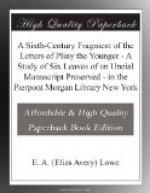Here is sufficient material for a test. Aldus, it will be observed, whether or not he started with some special edition, refuses to follow the latest and best texts of his day (i.e., _{sigma}_) in these twenty-six readings. In one sure case (60, 15) and eleven possible[62] cases (61, 18; 62, 26; 63, 5, 12, 15, 17 bis, 23 bis; 64, 2, 5), his reading agrees with the Princeps. In four sure cases (63, 4, 22; 65, 15; 66, 9) and one possible one (63, 9), he agrees with the Roman edition; in two sure (61, 12; 66, 11) and three possible (63, 2; 66, 7, 12) cases, with both p and r. Once he breaks away from all editions reported by Keil and agrees with D (62, 6). At the same time, all these readings are attested by _{Pi}FB_ and hence were presumably in the Parisinus. In two cases (65, 11, 24), we know of no source other than P that could have furnished him his reading. Further, in the superscription of the third letter of Book III (63, 20), he might have taken a hint from Catanaeus, who was the first to depart from the reading CORNELIAE, universally accepted before him, but again it is only P that could give him the correct spelling CORELLIAE.[63]
[Footnote 62: I say “possible”
because the reading is implied, not
stated, in Keil’s edition.
The reading of Beroaldus on 63, 23 I get
from our photograph, not from Keil, who
does not give it.]
[Footnote 63: I have purposely omitted
to treat Aldus’s use of the
superscriptions in P, as that matter
is best reserved for a
consideration of the superscriptions in
general.]
If all the above readings, then, were in the Parisinus, how did Aldus arrive at them? Did he fish round, now in the Princeps, now in the Roman edition, despite the repellent errors that those texts contained,[64] and extract with felicitous accuracy excellent readings that coincided with those of the Parisinus, or did he draw them straight from that source itself? The crucial cases are 65, 11 and 24. As he must have gone to the Parisinus for these readings, he presumably found the others there, too. Moreover, he did not get his new variants by a merely sporadic consultation of the ancient book when he was dissatisfied with the accepted text of his day, for in the two crucial cases and many of the others, too, that text makes sense; some of the readings, indeed, are accepted by modern editors as correct.[65] Aldus was collating. He carefully noted minutiae, such as the omission of et and iam, and accepted what he found, unless the ancient text seemed to him indisputably wrong. He gave it the benefit of the doubt even when it may be wrong. This is the method of a scrupulous editor who cherishes a proper veneration for his oldest and best authority.
[Footnote 64: See above, p. 58.]
[Footnote 65: See above, pp. 47 f.]




